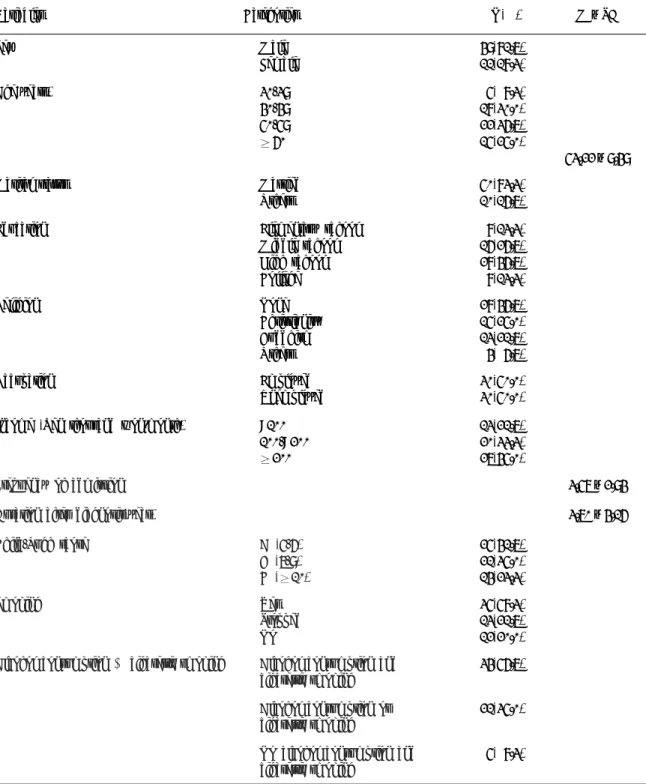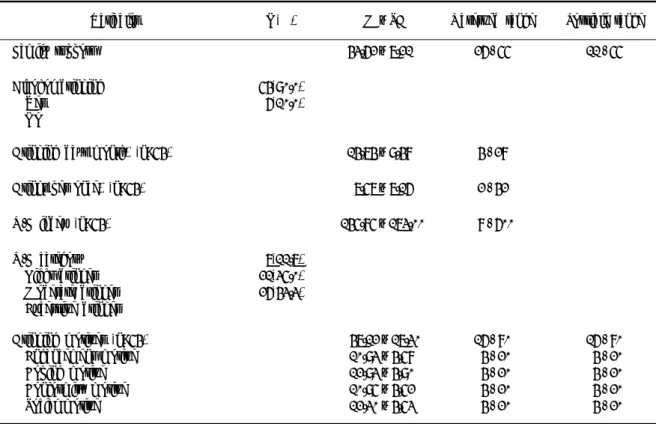주요용어 간경변증 가족지지 음주 음주동기: , , ,
서 론 I.
연구의 필요성 1.
2006
6 , 40-50
2
(Korea National Statistics Organization, 2006).
5 , 10 , 15 13%, 27%, 42%
(Kim, Kim, Lee, Yoon, & Song, 1994).
69.8%
82.7%, 59.5% (Korea
Center for Disease Control and Prevention, 2004).
63.6%, 67.5% (Chung & Kim, 2005;
Im, Lee, Park, Ryu, & Kim, 2003), Son (2001) 58.5%
.
.
간경변증 환자의 가족지지 음주정도 및 음주동기 ,
김남영
1
․ 김옥수2
, BK
1,
2Family Support, Alcohol Consumption and Drinking Motives in Patients with Liver Cirrhosis
Kim, Nam Young
1Kim, Ok Soo
21
Doctoral Candidate, College of Nursing Science, Ewha Womans University
2
Professor, College of Nursing Science, Ewha Womans University
Purpose: The purpose of this study were to investigate the level of family support, alcohol consumption and drinking
motives in patients with liver cirrhosis and to examine the relationships among those variables. Methods: The subjects consisted of 60 patients with liver cirrhosis. Family support scale, Q-F methods and Drinking Motives Questionnaire were used to measure the level of family support, alcohol consumption and drinking motives. Results:The level of family support was 43.62. Prevalence of drinking was 90% and 43.3% were currently heavy drinkers.
Alcohol consumption was related to sex and education. There were positive low relationships between the level of enhancement motive, coping motive, social motive, and Q-F Index. Conclusion: Alcohol drinking is a serious health problem in patients with liver cirrhosis. It is necessary to have an educational approach for controlling drinking and family support.
Key Words : Liver cirrhosis, Support, Alcohol drinking, Motivation
Corresponding address: Kim, Nam-Young, Doctoral Candidate, College of Nursing Science, Ewha Womans University, 11-1 Daehyn-dong,
,
, (Kasper et al.,
2005)
(Kerr, Filmore, & Marvy, 2000; Ramstedt, 2003; Serra, Escudero, Rodriguez, del Olmo, & Rodrigo, 2003).
90%
(Bagnardi, Blangiardo, La Vecchia, & Corrao, 2001).
, (Yang, 2004).
(Kim, 2000).
Son (2001)
(Harris
& Brunt, 1995; Yang, 2001)
. Cox Klinger(1990)
, Baik, Kim,
Joo, Bae Lee(2002) 46.5%
.
. Yoo(2000)
. .
,
.
연구의 목적 2.
,
. .
1) . 2)
.
3) ,
.
용어정의 3.1) :
(Cobb,
1976) Kang(1984)
11
.
2) : , 1
.
, 1
1 ,
Q-F(Quantity-frequency) Index (Cahalan, Roizen, & Room, 1976).
3) :
(Cox &
Klinger, 1990)
, , ,
(Shin & Han, 1999).
연구방법 II.
연구대상 및 기간 1.
2005 3 1 12 31 H
S 20
60 .
, .
.
연구도구2.
1)
Kang(1984) .
11 5 ‘
’(5 ), ‘ ’(4 ), ‘ ’(3 ), ‘
’(2 ), ‘ ’(1 )
, .
11 55 ,
. Kang(1984) Cronbach's alpha .86 , Cronbach's alpha .91 .
2)
, 1 ,
.
1 1
. Q-F Index
1
(unit) (Cahalan et
al., 1976). Q-F Index (1-12 ),
(13-52 ), (53 ) 3
Q-F category (Clapp & Segars, 1993).
1 (355ml), 1 (200ml),
1 ( , 50ml)
14gm (unit)
(Clapp & Segars, 1993).
3)
Shin Han(1999)
. 4 (
), (
), (
), (
) ,
. 1
5 ' '(1 )
‘ ’(5 ) .
16 80
. Shin Han(1999)
Cronbach's alpha , , ,
.76, .89, .80, .85 ,
Cronbach's alpha .93, .94, .94, .90 .
4)
Child- Pugh's scoring system(Child, 1964) .
. ,
1 3
1 .
5-15 5-6 Child A, 7-9 Child
B, 10 Child C
.
자료분석 방법3.
SPSS/WIN 12.0 .
1)
, ,
, , .
Table 1. General characteristics of the subjects (N=60)
Variables Categories N(%) M ± SD
Sex Male
Female
49(81.7) 11(18.3)
Age(years) 30-39
40-49 50-59 60
5( 8.3) 18(30.0) 22(36.7) 15(25.0)
53.22 ± 9.49
Marital status Married
Others
50(83.3) 10(16.7)
Education Elementary school
Middle school High school College
8(13.3) 16(26.7) 28(46.7) 8(13.3)
Religion None
Christianity Buddhism Others
28(46.7) 15(25.0) 13(21.7) 4( 6.7)
Occupation Employed
Unemployed
30(50.0) 30(50.0) Income (Ten thousand won/month) <100
100-<200 200
13(21.7) 20(33.3) 27(45.0)
Frequency of admission 3.57 ± 2.94
Duration after diagnosis(year) 3.70 ± 4.16
Child-Pugh score A (5-6)
B (7-9) C ( 10)
25(41.7) 21(35.0) 14(23.3)
Smoking Yes
Stopped No
35(58.3) 13(21.7) 12(20.0) Alcohol consumption & cigarette smoking Alcohol consumption and
cigarette smoking
34(56.7)
Alcohol consumption or cigarette smoking
21(35.0)
No alcohol consumption and cigarette smoking
5( 8.3)
t-test, ANOVA
, Scheffe
.
3) ,
Pearson Correlation coefficients .
연구결과 .
Ⅲ
대상자의 일반적 특성 및 질병관련 특성 1.
53.22 (±9.49) 40-50
66.7%(40 ) , 81.7%,
18.3% . 46.7%
60%
83.3%
3.70 (±4.16) 3.57 (±2.94) .
Child-Pugh Score Child A(5-6 )
41.7% , Child B(7-9 ) 35.05
%, Child C(10 ) 23.3% .
58.3%(35 ) ,
56.7%(34 ) .
대상자의 가족지지 음주정도 및 음주동기
2. ,
43.62(±7.21) . 90%(54 )
14.74(±9.48) 1
7.57(±7.16) . 43.3
%(26 ) 11.7%(7 ),
Table 2. Family support, alcohol drinking and drinking motives (N=60)
Variables N(%) M ± SD Observed range Possible range
Family support 43.62 ± 7.21 26 - 55 11 - 55
Alcohol drinking Yes
No
54(90.0) 6(10.0)
Drinking days(month) (n=54) 14.74 ± 9.48 4 - 28
Drinks(per once) (n=54) 7.57 ± 7.16 2 - 42
Q-F index (n=54) 145.85 ± 173.00 8 - 600
Q-F category Light drinker Moderate drinker Excessive drinker
7(11.7) 21(35.0) 26(43.3)
Drinking motives (n=54) Enhancement motive Coping motive Conformity motive Social motive
47.12 ± 17.30 10.93 ± 4.58 12.93 ± 4.90 10.95 ± 4.52 12.30 ± 4.53
16 - 80 4 - 20 4 - 20 4 - 20 4 - 20
16 - 80
4 - 20
4 - 20
4 - 20
4 - 20
Table 3. Differences among general characteristics, disease and alcohol drinking (N=54)
Variables N Q-F Index (M±SD) t/F(p) Scheffe test
Sex Male Female
47 7
158.72 ± 180.39 59.43 ± 69.99
2.661 (.015)
Age(years) 30-39 40-49 50-59 60
5 17 20 12
199.59 ± 89.26 179.14 ± 43.45 201.02 ± 44.95 104.90 ± 30.28
.263 (.852)
Marital Status Married Others
45 9
149.33 ± 176.38 128.44 ± 163.61
-.328 (.744)
Education Middle school High school College
21 25 8
84.57 ± 87.76 156.48 ± 186.81 273.50 ± 233.81
3.935 (.026) a b a>c c Religion
None Christianity Buddhism Others
23 14 13 4
170.61 ± 176.12 156.29 ± 199.27 109.23 ± 155.33
86.00 ± 130.05
.513 (.675)
Occupation Yes No
28 26
158.43 ± 194.61 132.31 ± 148.92
.551 (.584)
Income(Ten thousand won/month)
<100 100-<200
200
12 18 24
104.00 ± 87.92 117.11 ± 173.32 188.33 ± 199.06
1.340 (.271)
Frequency of admission 1
2 3
4
16 12 5 21
166.50 ± 194.40 135.83 ± 168.59 66.40 ± 55.90 155.05 ± 179.02
.448 (.720)
Duration after diagnosis(year) 1
1-<5 1-<10
10
19 23 6 5
211.16 ± 211.17 120.52 ± 147.98 127.33 ± 166.02 57.60 ± 63.28
1.551 (.213)
Child-pugh score A (5-6) B (7-9) C ( 10)
22 18 14
151.64 ± 181.73 166.89 ± 199.85 109.71 ± 119.84
.441 (.646)
(±17.30) , , , 10.93(±4.58) , 12.93 (±4.90) , 10.95(±4.52) , 12.30(±4.53) (Table 2).
대상자의 일반적 특성과 질병관련 특성에 따른 음 3.
주정도의 차이
(t=2.661, p=.015) (F=3.935,
p=.026) .
,
. , , , , , ,
, Child-Pugh Score (Table 3).
대상자의 가족지지 총 음주량 및 음주동기간의
4. ,
관계
.
(r=.320, p=.037), (r=.391, p=
.010) (r=.341, p=.025)
(Table 4).
논 의 .
Ⅳ
81.7% 40-50
66.7% 4 ,
system (Child, 1964) Child
A(5-6 ) 41.7% , Child B(7-9 )
Child C(10 ) 35.05%, 23.3% .
Child A 15-20 ,
10% , Child B
, 30% .
Child C 1-3 ,
82% (Feldman, Friedman,
& Sleisenger, 2002). 58%
Child B, Child C
.
58.3% .
Chung Kim(2005) 36.2%
, Son (2001) 49.0%
.
91.7%, 8.3%
.
3.97
. Hwang
Kim(2005) 4.38
. Son (2001)
58.8% ,
Table 4. Relationships among family support, drinking motives and Q-F index
Variables Family support r(p) Q-F index r(p)
Drinking motives (n=54) Enhancement
Coping Conformity Social
-.154(.324) -.239(.122) -.200(.198) -.133(.396)
.320(.037)*
.391(.010)*
.203(.191) .341(.025)*
Family support -.167(.227)
. Chung Kim(2005), Im, Lee, Park, Ryu Kim(2003)
63.6% 67.5%
. Jung, Park, Lee Kim(2002) 50%
. Kim(2002)
.
.
2 1 8 (
1 ) . Chung Kim(2005)
34.5%, 34.4% .
35.0% ,
43.3%
. .
.
. Shin Han(1999)
.
10.93 , 12.93 , 10.95 ,
12.30 .
, , ,
9.57 , 10.24 , 9.08 , 12.71 Baik, Kim,
Joo, Bae Lee(2002) ,
.
, .
.
, , , , ,
, , Child-Pugh Score
. 66.7% 40-50
81.7%
(Kim, 2002). Child-Pugh
Score, .
(Yang, 2004)
. ,
.
.
. .
Shin Han(1999)
.
Cooper (1995) Cooper(1994)
.
,
.
69.8%(Korea Center for Disease Control and Prevention, 2004)
.
결론 및 제언.
Ⅴ



